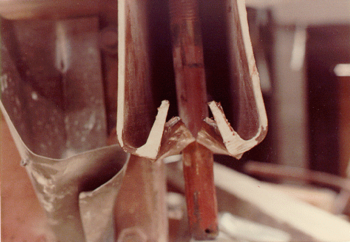The DU Lounge
Related: Culture Forums, Support ForumsToday is the 37th anniversary of the collapse of the Hyatt Regency walkway.
The Hyatt Regency walkway collapse took place at the Hyatt Regency Kansas City hotel in Kansas City, Missouri, on July 17, 1981. Two walkways, one directly above the other, collapsed onto a tea dance being held in the hotel's lobby. The falling walkways killed 114 and injured 216. It was the deadliest structural collapse in U.S. history until the collapse of the World Trade Center towers 20 years later.
....
Disaster
On the evening of July 17, 1981, approximately 1,600 people gathered in the atrium to participate in and watch a tea dance. At 7:05 p.m. local time (00:05 UTC; July 18) the second-level walkway held approximately 40 people with more on the third and an additional 16 to 20 on the fourth level who watched the activities of the crowd in the lobby below. The fourth-floor bridge was suspended directly over the second-floor bridge, with the third-floor walkway offset several meters from the others. Construction difficulties resulted in a subtle but flawed design change that doubled the load on the connection between the fourth-floor walkway support beams and the tie rods carrying the weight of both walkways. This new design was barely adequate to support the dead load weight of the structure itself, much less the added weight of the spectators. According to an episode of Seconds From Disaster, many of the survivors reported hearing popping noises coming from above them shortly before the collapse. Only moments later, the fourth-floor walkway suddenly dropped several inches under the spectators, before falling completely onto the second-floor walkway. Both walkways then crashed to the lobby floor below, resulting in 111 deaths at the scene and 219 injuries. Three additional victims died after being transported to hospitals, bringing the total number of deaths to 114.
The rescue operation lasted 14 hours and was performed by many emergency personnel, including crews from 34 fire trucks and EMS units and doctors from five local hospitals. Trapped survivors were buried beneath more than 60 tons of steel, concrete and glass, which neither the Hyatt's forklifts nor the fire department's most powerful jacks could move. Additional volunteers from surrounding areas responded to the fire department's requests for help, including construction companies and building-supply stores, bringing hydraulic jacks, acetylene torches, compressors, jackhammers, concrete saws and generators. Kansas City's natural disaster response team, known as "Operation Bulldozer", was also summoned to the scene with earthmoving equipment, but was quickly sent away to make room for cranes that would lift the sections of walkway off the trapped survivors. Dr. Joseph Waeckerle, former chief of Kansas City's emergency medical system, directed the rescue effort establishing a makeshift morgue in a ground floor exhibition area, using the hotel's driveway and front lawn as a triage area and helping to organize the wounded by greatest need for medical care. Those people who could walk were instructed to leave the hotel to simplify the rescue effort; those mortally injured were told they were going to die and given morphine. Often, rescuers had to dismember bodies to reach survivors among the wreckage. One victim's right leg was trapped under an I-beam and had to be amputated by a surgeon, a task which was completed with a chainsaw.
One of the great challenges of the rescue operation was that the hotel's sprinkler system had been severed by falling debris, flooding the lobby and putting trapped survivors at great risk of drowning. As the pipes were connected to water tanks, not a public source, the flow could not be stopped. Mark Williams, the last person rescued alive from the rubble, spent more than nine and a half hours pinned underneath the lower skywalk with both of his legs pulled out of their sockets. Williams nearly drowned before Kansas City's fire chief realized that the hotel's front doors were trapping the water in the lobby. On his orders, a bulldozer was sent to break through the doors, which allowed the water to pour out of the lobby and thus eliminated the danger to those trapped. A fire hose was then placed over the broken pipe, redirecting the water outside the hotel. Additionally, the lobby was filled with concrete dust, and visibility was poor as the emergency workers had cut the power to prevent fires.
Twenty-nine people were rescued from the rubble.
....
Investigation
Three days after the disaster, Wayne G. Lischka, an architectural engineer hired by The Kansas City Star newspaper, discovered a significant change to the original design of the walkways. Reportage of the event later earned the Star and its associated publication the Kansas City Times a Pulitzer Prize for local news reporting in 1982. Radio station KJLA would later earn a National Associated Press award for its reporting on the night of the disaster.


Investigators found that changes to the design of the walkway's steel tie rods were the cause of its failure.
....
This design change proved fatal. In the original design, the beams of the fourth floor walkway had to support only the weight of the fourth floor walkway, with the weight of the second floor walkway supported completely by the rods. In the revised design, however, the fourth floor beams were required to support both the fourth floor walkway and the second floor walkway hanging from it.
....
Aftermath
The engineers employed by Jack D. Gillum and Associates who had "approved" the final drawings were found culpable of gross negligence, misconduct and unprofessional conduct in the practice of engineering by the Missouri Board of Architects, Professional Engineers, and Land Surveyors. Even though they were acquitted of all crimes that they were initially charged with, they all lost their respective engineering licenses in the states of Missouri, Kansas and Texas and their membership with ASCE. Although the company of Jack D. Gillum and Associates was discharged of criminal negligence, it lost its license to be an engineering firm.
At least $140 million was awarded to victims and their families in both judgments and settlements in subsequent civil lawsuits; a large amount of this money was from Crown Center Corporation, a wholly owned subsidiary of Hallmark Cards which was the owner of the hotel real estate. As is the practice of many hoteliers, Hyatt operated the hotel for a fee as a management company, and did not own the building. Life and health insurance companies are likely to have absorbed even larger uncompensated losses in policy payouts.
The Hyatt collapse remains a classic model for the study of engineering ethics and errors, as well as disaster management. As an engineer of record for the Hyatt project, Jack D. Gillum (1924–2012) occasionally shared his experiences at engineering conferences in the hope of preventing future mistakes.
....

The crucial detail involved in the 1981 skyway collapse in Kansas City. Image: DTR/Wikimedia Commons
December 16, 2015
Until the events of 9/11, the skywalk collapse at the former Hyatt Regency hotel in Kansas City, Mo., was the most devastating structural failure ever in the U.S. in terms of loss of life and injuries—and the cause was a direct result of engineers who violated their ethical code.
The tragedy took place on the night of July 17, 1981, during a “tea dance” with 1,500 people in attendance. Because two engineers behaved with conscious indifference toward their professional duties, 114 people died and another 216 were injured. On a beautiful, clear autumn day 34 years later, Kansas City dedicated the Skywalk Memorial Plaza to the first responders, the victims and the survivors of this engineering failure.
....
Flawed Original Design
Few people know or remember that the original design also would have failed, as seen in the deflection of flanges of the box beam on the one skywalk that remained. The engineers failed to conduct stress calculations on either design, yet the structural engineer-of-record, Gillum, applied his professional seals. ... The same company whose cranes lifted wreckage off the victims that night also lowered the memorial sculpture into place. Kansas City will always remember the skywalk collapse.
For professionals, the disaster provides enduring lessons. First responders are taught the skywalk collapse as a case study in the “all-hazard approach” when dealing with multiple disciplines across jurisdictions. Architects and engineers study this case in classes on structures, design, and professional ethics. ... But for engineers, the disaster holds special significance. We must always remember that while our actions better the lives of the public, our misconduct risks those same lives. We can do no less than to take this lesson into our hearts and minds and live up to the expectations of the public.
Robynn Andracsek, P.E., is associate environmental engineer for Burns & McDonnell Engineering Co., based in Kansas City, and a freelance writer. She can be reached at randracsek@burnsmcd.com.
If you have an idea for a column, please contact Viewpoint Editor Richard Korman at kormanr@bnpmedia.com.
KCDebbie
(664 posts)all available emergency crews had been summoned to the Hyatt and I assumed that the rotating restaurant on top of the building had fallen off...
sinkingfeeling
(51,448 posts)exboyfil
(17,862 posts)Physics I. First step is draw the system and place forces.
wcmagumba
(2,886 posts)down the road from KC and remember this well, some college friends from there
were over for a get together and we watched in horror the news reports...still bugs
me and I don't really like going in the Crown Center Complex even today. Here is a
reddit (I know) thread with some interesting comments.
https://www.reddit.com/r/kansascity/comments/6o0suh/yesterday_marked_36_years_since_the_hyatt_walkway/?st=jjpzsxuf&sh=b4b62dc7
There was a KC rock group called the Rainmakers, that did a song about this (which I like) but it (the song) was apparently banned from KC radio stations for a time.
Floyd R. Turbo
(26,546 posts)screw ups that occur during construction, many of which result from design changes to save a few bucks.
MuseRider
(34,106 posts)I had a friend who lost his sister and another whose mother was gravely hurt. They were members of the Mariachi band from Topeka. There is a statue commemorating them at our Performance Center. It was so scary and sad around here after that happened.
bobbieinok
(12,858 posts)Iggo
(47,552 posts)I didn't know that about the original design.